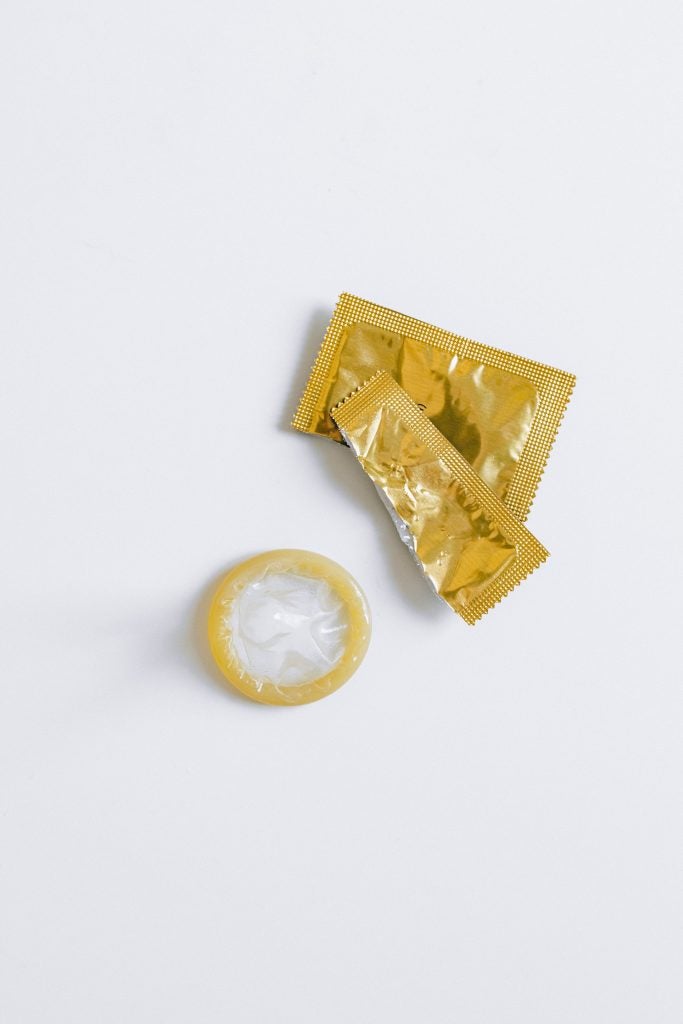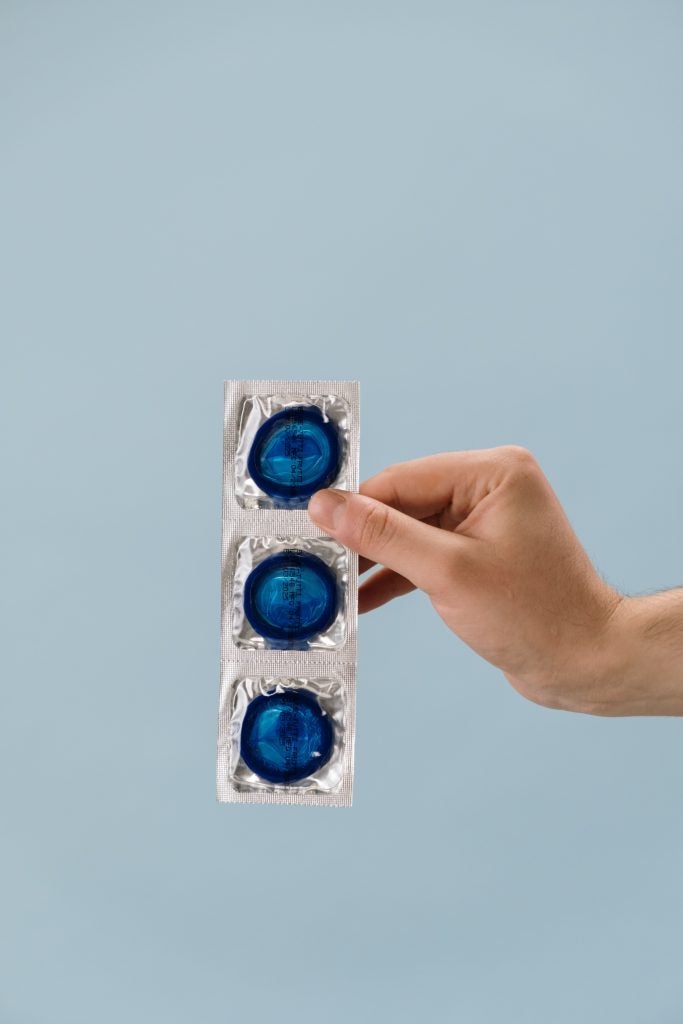
Table of Contents
Background
Condoms are a barrier method of contraception that can prevent unwanted pregnancies and the spread of sexually transmitted infections. A male condom is a thin sheath that is placed over the user’s erect penis before sexual activity to prevent direct contact of the penis with the partner’s skin, mucosa, and genital secretions.1 Though not as prevalent, condoms also exist for female use, typically referred to as female condoms. It is important to note that female condoms can also be used in the anus for purposes of anal sex, leading some circles to refer to them as “internal condoms,” but are more widely known as female condoms. Condoms have been in existence for thousands of years, but have only started to become widely used within the past one hundred years.
Timeline
11,000 B.C.E.
The first appearance of the condom came around 11,000 B.C. Two caves in France known as Grotte des Combarrelles are known to have paintings on the walls that scientists claim represents condoms. Scientists believe that this was the first evidence of condom usage.2
3,000 B.C.E.
The first evidence of a female condom (also known as an internal condom) dates back to around 3,000 B.C.E., when it makes an appearance in texts such as Homer’s The Iliad. According to the texts from this time period, a goat’s bladder was inserted into the vagina of King Minos’ wife to protect her from King Minos’ evil poisoned semen. While the bladder did protect her from the poison, she still ended up giving birth to eight children, so the condom was not portrayed as a use of contraception specifically.3
1,000 B.C.E.
Historians believe that in ancient Egypt, people used a linen sheath around the penis as protection against troublesome insects and tropical diseases.2,4 The Romans used animal bladders for similar purposes. At the time, the linen sheath was only used for disease prevention; the Egyptians did not know about the sheaths’ contraceptive properties.3 Additionally, to prevent infection, the Chinese wrapped oiled silk paper around the penis, while the Japanese used leather and tortoise shell sheaths. During this time period, using materials made from animal parts was very common.2
1400s
In Asia, particularly China and Japan, the first condom to be used was the Glans condom. The Glans condom only covered the head of the penis, and was primarily used as a form of birth control, but was also used to protect against infections. In China, obscure materials such as silk or lamb intestines were used to make the condom. In Japan, materials such as tortoise shells or animal horns were used.2,4
1500s
In the 16th century, an Italian inventor named Gabrielle Fallopius produced the first documented work on the dangers of the STI syphilis. He invented and recommended using a protective linen sheath soaked in chemicals in order to prevent the spread of syphilis. After the linen soaked, the manufacturer would dry it and attach a ribbon on the bottom, which would later be used to tie the sheath around the shaft of the penis. Gabrielle Fallopius conducted an experiment consisting of 1,100 participants that determined the effectiveness of the condom in the protection against syphilis. None of the participants were infected with the disease, proving the success of the first condom that effectively protected against STIs.2,4
1600s
Once Fallopius published his paper on condom STI protection, people became more skeptical of the idea of the condom and controversy on whether to use it or not began to stir in scientific and religious communities. In 1605, Catholic theologian Leonardus Lessius claimed that condoms were immoral, thus becoming the first documented religious figure to oppose the condom.2 Around the same time, condoms made from animal intestines became widely available to the public. Even so, many people reused them because of their expensive nature. Reusing linen condoms is unsanitary and can even increase the possibility of spreading STIs, but many people were not aware of this fact.2 In 1666, the English Birth Rate Commission credited “condons” (which eventually evolved into today’s English word “condoms”) for the drop in birth rate.2
Makeshift versions of the female condom were used by the Djuka tribe of New Guinea during this time. They were about six inches long, made of plant material, and goblet shaped. They were inserted in the vagina just prior to intercourse and held in place by the muscles within the vaginal wall.3
1700s
By this time, the public was becoming much more aware of condoms and their uses. Again, as public awareness increased, so did the skepticism on whether condoms protected against pregnancy and STIs. English physician Daniel Turner reportedly stated his belief that condoms encourage men to have unsafe sex with different partners. In fact, around this time, many physicians condemned the use of condoms on moral grounds. Nevertheless, the condom market continued to expand. Condoms, often made of either “skin” (intestine or bladder treated with sulfur or lye) or linen soaked in chemicals, became more widely available and began being sold in public places, like pubs or markets.2,4

1800s
In the early 1800s, many people’s views about condoms began to expand. Some people began to advocate publicly for the use of condoms, while others continued to discredit condom use. Members of Parliament in the United Kingdom tried to ban condoms because they believed that they did not offer sufficient protection against syphilis, and that they encouraged unsafe and irresponsible sex. Although people discredited the use of condoms, the condom market was expanding rapidly as they became available to the working class. Up until this point in history, all condoms had been made out of linen or animal skin. In 1839, Charles Goodyear invented rubber vulcanization, but the first rubber condom was not produced until 1855.2,3,5 Just a few short years later, the majority of rubber companies were producing condoms as well. These condoms were reusable, which meant they were much more affordable.3,4 However, skin condoms still tended to be more popular, mainly because they were lower in cost. One of the problems with early rubber condoms was that they were “custom made” (each person was fitted specifically), yet they could easily fall off as they only covered the glans of the penis. Eventually, condom manufacturers realized that they could mass produce condoms that would fit everyone at a much more reasonable cost. The history of condoms was forever changed when the rubber condom was invented because they were now able to successfully protect against pregnancy and STIs while also being very widely available. These newly invented rubber condoms are also what caused people to refer to condoms as “rubbers,” a term that remains in use today.2,4
1900s

Many advancements to condoms came within the 1900s. These advancements began when condoms were distributed to military personnel during World War I, as they were shown to lower the rate of transmitting STIs. By this time, use of the linen condom died out mainly because animal-based condoms had become more easily accessible and were more comfortable to wear than their linen counterparts.3 Before the war, the majority of condoms distributed in Europe were provided by Germany, but this changed drastically throughout World War I. Julius Fromm, a German chemist, created a new method of manufacturing condoms, in which he dipped glass molds into raw rubber solution. This method allowed the rubber to adopt whatever bumps or ridges were on the glass, thus giving the condoms texture. His line of condoms, Fromm’s Act, remains popular in Germany today.2,4 In 1918, a judge ruled that condoms could be sold and advertised for the prevention of disease, although they could not be sold as contraceptives. As a result, condom sales doubled in the early 1920s. In the later 1920s, latex was invented, which gave rise to the first latex condom. The manufacturing of the latex condom involved suspending rubber in water, which allowed the latex to mold into the shape of a penis. Latex condoms were first mass produced by Young’s Rubber Company and were much cheaper than linen condoms due to the minimal amount of labor required. Additionally, London Rubber Company created Durex, the first latex condom brand, which is still a well-known and widely-distributed brand today. Throughout the 1920s, skin condoms lessened in popularity as latex condoms began to be mass produced. However, these condoms were not known for their effectiveness as they often leaked and were unreliable. Therefore, the FDA (U.S. Food and Drug Administration) mandated that a condom was a drug, and that every condom must be tested before it left the factory. The acceptance and popularity of condoms continued to grow throughout the mid 1900s and in 1957, Durex created the first condom with lubrication.2 Even with all the improvements and increased acceptance, the use and sale of condoms didn’t really skyrocket until the AIDS epidemic. When scientists discovered HIV to be a sexually transmitted infection, condoms began to be marketed as a way to prevent HIV. People discovered that condoms were the most effective and one of the only barrier methods that would allow them to have sex while protecting against the disease.4 In 1997, Durex created the first condom company website, marking a milestone in the progress of condom use worldwide.2
Furthermore, the 1900s saw great progress for the female condom. In 1937, a concept for what a female condom might look like surfaced, but the female condom was not actually invented until the 1980s. In 1984, a Danish physician named Lasse Hessel developed a prototype for the first female condom. It contained three important aspects that successfully reduced the risk of sexually transmitted infections and that protected against unintended pregnancy. First, it contained a sheath that lined the vagina. Second, it included an external ring that covered any external genitalia, and that prevented the condom from being pushed deep into the vagina during intercourse. Lastly, it had an internal ring which both assisted with initial insertion into the vagina and prevented the condom from being pushed into the cervix, which could be very painful. After Hessel developed a prototype, he partnered with a chemical product company named Wisconsin Pharmacal Co. to further develop the design, making sure that the female condom would meet the FDA requirements. The first generation female condom, named FC1, was made from polyurethane and the second generation female condom, FC2, was made from synthetic nitrile. The FC2 was designed to take the place of FC1, as it provided the same safety and efficiency but at a lower cost. It was also designed to make less distracting (and potentially mood-killing) crinkling noises compared to the FC1.6
2000s – Today
After Durex created the first condom company website, condoms became a common household term. Sexual education throughout the United States now incorporates and encourages the use of condoms to practice safe sex. Today, you can find many variations of the classic condom, from different sizes, to shapes, to colors, and even flavors. If the cost of condoms discourages you from using them, many organizations, such as Planned Parenthood, and the majority of college campuses now give out free condoms as a way to promote safe sex. These days, condom use is practiced by billions across the world and is one of the best ways to promote and practice safe sex.4
Despite the condom’s popularity, the worldwide use of female condoms is much lower than that of male condoms, but the World YMCA is trying to push an initiative for increased female condom use. In 2005, the YMCA contacted international donors and health clinics and requested that they purchase 180 million female condoms, stating that “female condoms remain the only tool for HIV prevention that women can initiate and control.” That year, between 6 and 9 billion male condoms were distributed compared to only 12 million female condoms.6
The Future of Condoms
In March of 2013, the Bill and Melinda Gates Foundation issued a challenge to the public to develop a condom that is safe and effective while still preserving pleasure for the user. While many proposed their ideas, 22 grants were awarded to organizations claiming to have the next generation of condoms.7 Many designs utilized materials that are still being explored in the scientific community, such as graphene, nanofabric, hydrogel, and many others. All materials are designed to be easier and/or more pleasurable for the person using the condom, whether that’s through conducting heat, shrinking around the penis during intercourse, or making the condom sturdier so that it’s less likely to break. Each awarded party received $100,000 from the Bill and Melinda Gates Foundation to promote development of their product. The design proposed by Texas A&M University professor Mahua Choudhury has since been endorsed by India’s government as an HIV prevention initiative. Most of the winning designs are still in the testing phases of development, but with adequate funding and government support, the innovated condoms will likely be more prominent in the near future.7,8
Concluding Remarks

Today, condom use is in the billions and continues to grow every year. The transmitting of STIs has significantly dropped as well as the number of unintentional pregnancies due to condom use by people across the world. Many types of condoms are now available to fit and suit every individual just as they please. Every individual has a different preference on size, texture, and lubrication and today’s condom market allows people to choose whatever they prefer for their sexual experiences.
References
- “Male Condom, SexInfo Online. N.p., n.d. Web.
- “The Condom Timeline: A Detailed History Of Wrapping It Up.” The Condom Timeline: A Detailed History Of Wrapping It Up. N.p., 2015. Web.
- Finch BE, Green H. In: Contraception through the Ages. Charles C, editor. London: Thomas Publishers; 1964.
- Vilijn, Marijke. “Condomerie, History of the Condom. N.p., 2010. Web.
- “The History of the Condom.” Condom Sizes. N.p., 16 Nov. 2012. Web.
- “Product History, FCMi+. N.p., n.d. Web.
- “Develop the Next Generation of Condom (Round 11).” Bill and Melinda Gates Foundation. 4 March 2013.
- “Texas A&M prof proposes new condom that fights HIV infection.” vol. XLI, no. 6. 25 December 2015. India – West: San Leandro, CA, 25 December 2015.
Last Updated 7 January 2019
